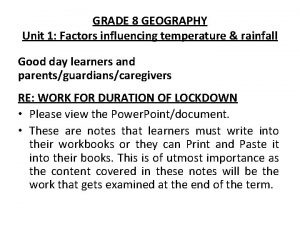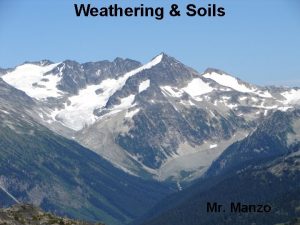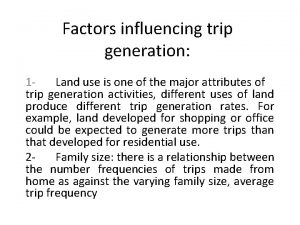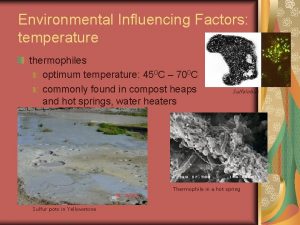GRADE 8 GEOGRAPHY Unit 1 Factors influencing temperature









- Slides: 9

GRADE 8 GEOGRAPHY Unit 1: Factors influencing temperature & rainfall Good day learners and parents/guardians/caregivers RE: WORK FOR DURATION OF LOCKDOWN • Please view the Power. Point/document. • These are notes that learners must write into their workbooks or they can Print and Paste it into their books. This is of utmost importance as the content covered in these notes will be the work that gets examined at the end of the term.

• I would suggest that the learners spends a maximum of 2 hours per week on the subject which would sufficiently cover the class time that is being lost. For example, Tuesday and Thursday, one hour each day. • Please first read through the content covered in the textbook at least twice. (Pgs 78 – 81). • Then read through the notes/summary and make sure that it is written or pasted in your notebooks. • Complete Activity 1 – pg. 81 (Unit 2 will be available on Wednesday. )

Factors influencing temperature and rainfall 1. 1 Distance from the equator (latitude) 1. 2 Distance from the sea 1. 3 Height above sea level (altitude) 1. 4 Ocean currents and winds 1. 5 Mountains (relief)

1. 1. Distance from the Equator (Latitude) Temperature Rainfall Cooler/Colder temperatures are found near the poles (North and South Poles). In polar areas we can expect snowfall because the air is colder and descends. Hot temperatures are found near the equator. Because it is warmer around the equator, we can expect more rainfall here. Hot and cool temperatures are found near the Tropics.

1. 2. Distance from the Sea Inland areas are Hotter in Summer and Colder in Winter; and receive LESS rainfall due to the distance travelled from the sea. SEA Temperature changes at a slower rate than LAND temperature; therefore coastal areas will have milder winters & cooler summers.

1. 3. Height above sea level (Altitude) Temperature: The higher you go, the colder it becomes because air temperature depends on air density. Air at higher altitudes: less dense and colder (convection) Air at lower altitudes: more dense and warmer (conduction) Rainfall: The higher the altitude, the cooler it becomes, therefore cooling moisture condenses and forms rain droplets. Mountain areas receive more rainfall than flat or lower areas.

1. 4. Ocean Currents and Winds COLD BENGUELA CURRENT (from the Poles) cools down the WEST COAST of South Africa WARM AGULHAS CURRENT (from the Tropics & Equator) warms up the EAST COAST of South Africa LESS rainfall along the WEST COAST of South Africa due to the COLD current. MORE rainfall along the EAST COAST of South Africa due to the WARM current.

1. 5. Mountains (Aspect)

1. 5. Mountains Warmer slopes have higher temperatures so they receive more rain. The closer the slopes are to the equator, the warmer they are. The closer the slopes are to the poles, the colder they are. Leeward slopes (facing away from the equator) have less rainfall. Slopes close to the poles have snowfall.
 5 factors that influence temperature and rainfall grade 8
5 factors that influence temperature and rainfall grade 8 Dynamic personality meaning
Dynamic personality meaning Factors influencing chemical weathering
Factors influencing chemical weathering Objectives of wage and salary administration
Objectives of wage and salary administration Physical factors influencing agriculture
Physical factors influencing agriculture Horizontal displacement of a projectile
Horizontal displacement of a projectile Contemporary nursing definition
Contemporary nursing definition Factors influencing trip production
Factors influencing trip production Pricing policies
Pricing policies Factors influencing destination image
Factors influencing destination image

















